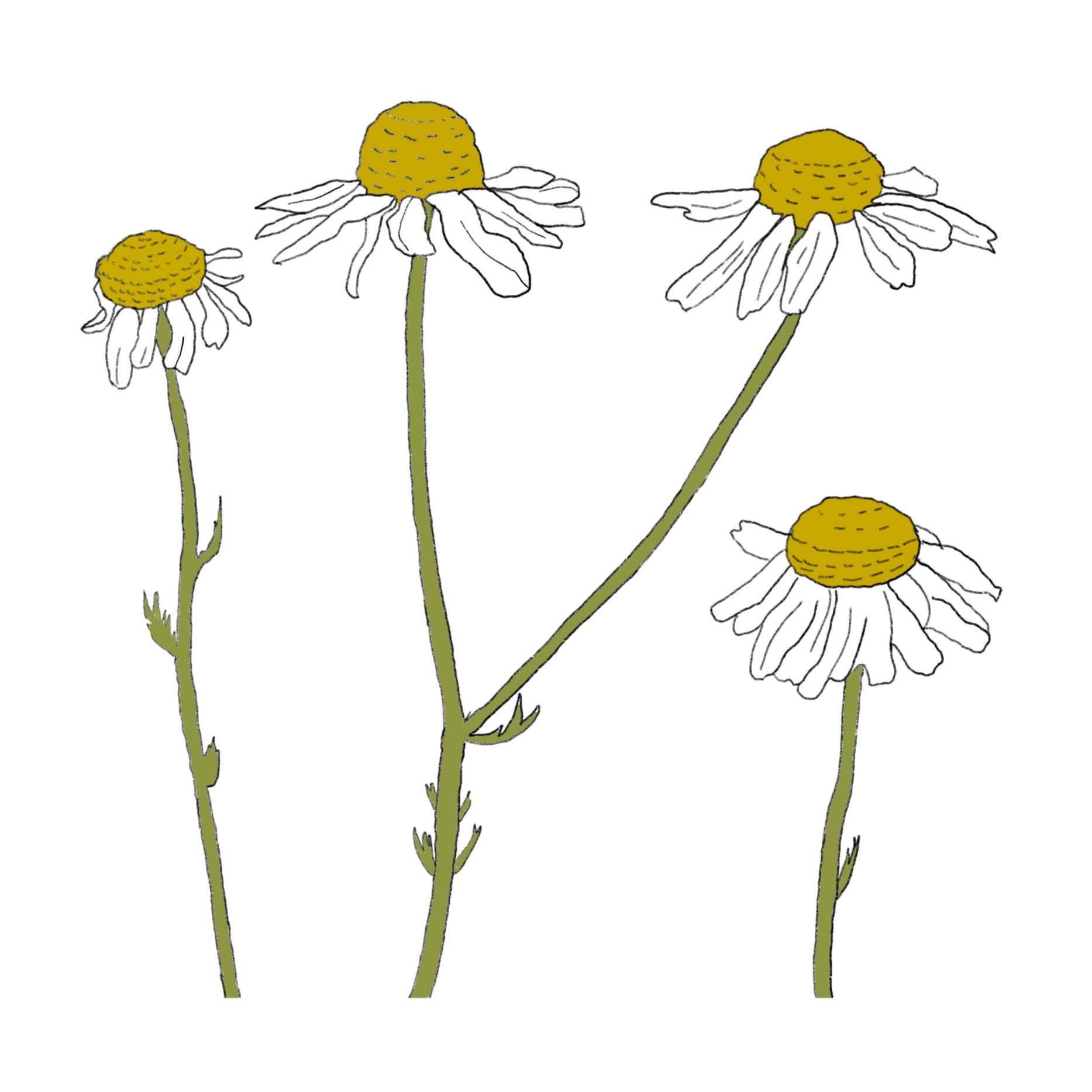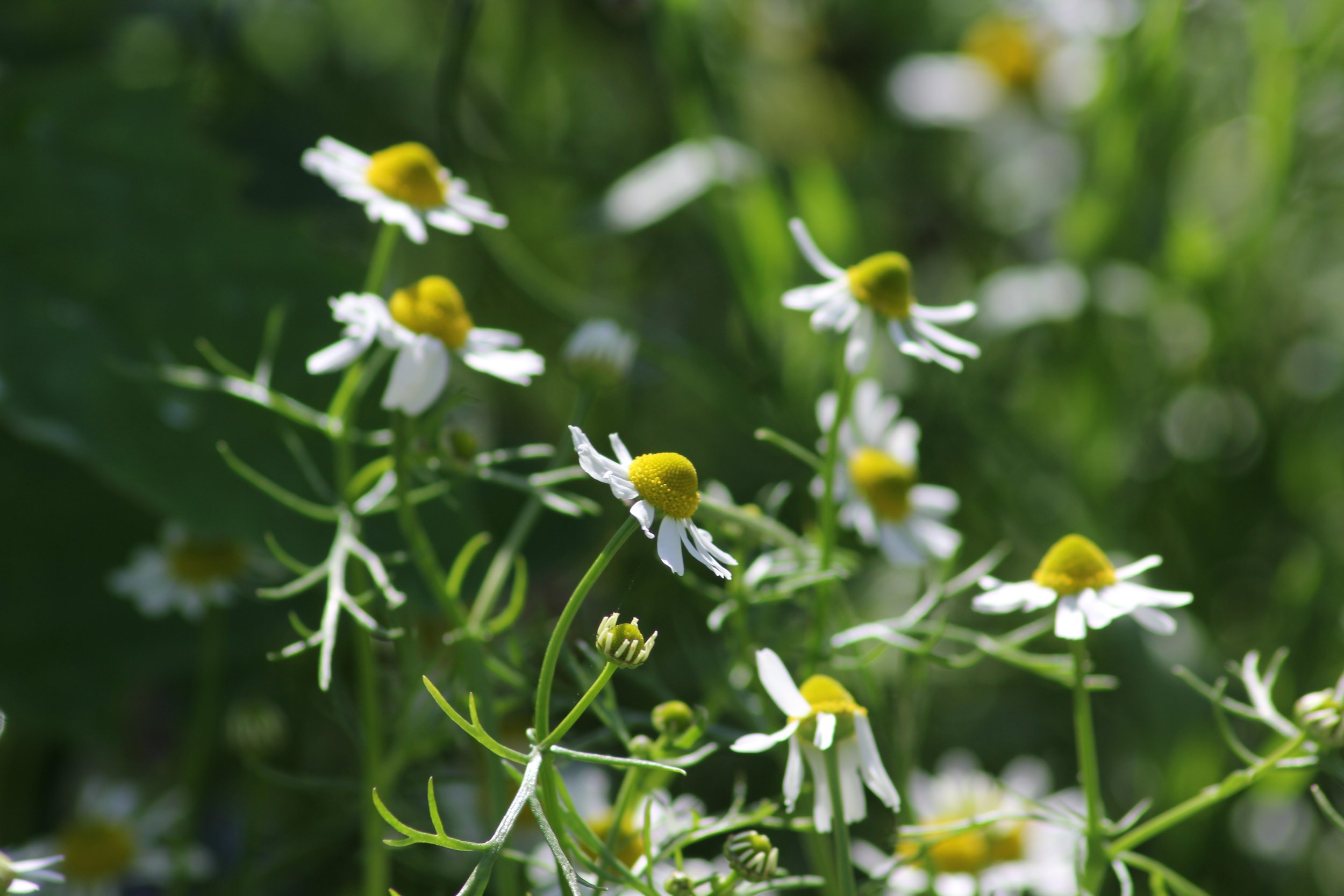Chamomile flower tea
Chamomile flowers in our garden.
Filling the gaps in between rows of vegetables in our kitchen garden. Peeping out between tall stalks of mint in our large planters. Reappearing in places I’d forgotten I’d sprinkled seed. Chamomile – Matricaria recutita – blooms from June and through summer in our garden in Dunoon.
As a hot brew addict, planting for my cup is one of my main reasons for growing herbs. Now it’s growing and setting seed around the garden, chamomile should reappear each year with minimal effort on my part. Constant calming cups of chamomile tea will continue as part of my day.
What’s it good for?
Chamomile flower tea is a sweet-smelling and sweet-tasting brew, with a mildly bitter edge. That bitterness makes it good for your digestion. Although evenings are when I mostly enjoy a chamomile cuppa, whenever you’re feeling like it’s time to relax, chamomile’s soothing properties make it a calming tea at any time of the day.
How to grow
Chamomile is really hardy and grows well in our veg beds and mint planters, which are topped up with fresh compost each year. It’s not too fussy about nutrition and conditions as long as the soil isn’t waterlogged. I do notice though that it’s growing more lusciously in our veg beds than in pots.
Best sown from seed in spring, chamomile seed can be sprinkled where you want it to grow outdoors or you can start seed off indoors in small pots on a warm windowsill. Keep the pots inside or in your greenhouse until your seedlings are a few inches big. From May onwards, you can start to put the pots outdoors in the daytime, to acclimatise the foliage to the outdoors. From the end of May onwards, plant them outside. By mid-summer, you should have some tea-worthy blooms.
How to harvest
It’s the pollen in the yellow centre of the flowers that give you the best flavour and most beneficial properties – this is where the essential oils are.
When chamomile flowers are open and at their peak, and before the white sepals begin to fade, harvest the flowers.
You can cut whole stems off down at the base and then use the stem for hanging up to dry. If using fresh flowers, you can cut flowers from different plants, leaving some for another day or to set seed for another flush.
Chamomile flowers
You can grow these dainty and aromatic flowers easily from seed.
How to dry or store
Drying herbs and storing them in jars or air-tight tins, gives you organically grown herbs to hand year-round.
Chamomile, despite growing lots of it, rarely makes it to my drying rack because I use most of what we grow through summer.
If you do want to dry and store some of your crop, they are best harvested at their peak, before the white sepals begin to fade. Harvesting on a dry day helps as they’re less damp for you to start the drying process.
Although it’s the flowers you’re after, you can cut off full stalks and tie a bunch together and hang them up somewhere warm and airy to dry. The yellow flower heads can turn into fine dust, and you want to capture that. As they start to turn, move them onto a muslin cloth or piece of paper to collect all the goodness. You can compost the stalks and keep the flowers.
Store in a sterilised jar out of direct sunlight.
How to brew
Freshly harvested flower heads can be brewed in a pot or cup of boiled hot water for 10 to 15 minutes to really infuse the flavour. When you are ready to serve, simply pour the infusion through a small strainer or sieve, or use an infuser teapot.
To brew dried chamomile, if it’s gone powdery, it’s best to use a piece of muslin or a paper teabag to brew, or an infuser with a tight mesh rather than holes, which will let the powder out.
The ritual of making tea is as essential as the flavour and aroma of your chosen herb. Taking your time to enjoy harvesting flowers you’ve grown yourself, boiling the water and finding your favourite cup are all part of the experience.
Find your own flavour
I enjoy the blend of the sweet and bitter taste, but some prefer it sweeter by adding honey or sugar.
How to serve
Share with friends and family. Pour into your favourite cup, sit back and put your feet up. Enjoy.
Alternatively, for a summer tonic, leave to cool and add ice, lemon and mint for a summer drink.
Herbs to blend with
To add to the calming effect, you can also add a teaspoon of lavender flowers or rose petals.
To perk it up, add a slice of lemon or a mint leaf for that extra zing.
be careful if
Plants can affect each of us differently. Do be cautious using herbs if you are pregnant or breastfeeding (find out which are safe to use) or taking medications for medical conditions – check with a qualified herbalist or your doctor first. If you have an allergy to plants in the daisy family, best avoid chamomile. More info see on PFAF.org.
There are other chamomiles out there, some native wildflowers and a low-growing chamomile that can be grown as an alternative to a lawn. My preferred chamomile for tea is Matricaria recutita, which has a lovely taste (less bitter) and a long history of use as a herb. Use a guide to make sure you’re harvesting the right chamomile. While I’m not aware of any health problems if you were to accidentally harvest a wildflower rather than the herb, it’s worth learning how to recognise the correct plants.
photos and words by Lynne Maclagan, drawings by Alan Lyons, Papaver Gardening



